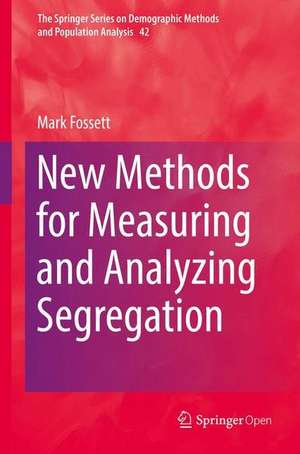New Methods for Measuring and Analyzing Segregation: The Springer Series on Demographic Methods and Population Analysis, cartea 42
Autor Mark Fossetten Limba Engleză Hardback – 22 sep 2017
This book is open access under a CC BY-NC 2.5 license.
| Toate formatele și edițiile | Preț | Express |
|---|---|---|
| Paperback (1) | 391.99 lei 6-8 săpt. | |
| Springer International Publishing – 22 iun 2018 | 391.99 lei 6-8 săpt. | |
| Hardback (1) | 397.97 lei 6-8 săpt. | |
| Springer International Publishing – 22 sep 2017 | 397.97 lei 6-8 săpt. |
Din seria The Springer Series on Demographic Methods and Population Analysis
- 18%
 Preț: 951.14 lei
Preț: 951.14 lei - 15%
 Preț: 643.99 lei
Preț: 643.99 lei - 15%
 Preț: 643.16 lei
Preț: 643.16 lei - 18%
 Preț: 955.56 lei
Preț: 955.56 lei - 18%
 Preț: 952.40 lei
Preț: 952.40 lei -
 Preț: 393.90 lei
Preț: 393.90 lei -
 Preț: 393.74 lei
Preț: 393.74 lei - 15%
 Preț: 639.08 lei
Preț: 639.08 lei - 18%
 Preț: 952.89 lei
Preț: 952.89 lei - 18%
 Preț: 1118.45 lei
Preț: 1118.45 lei -
 Preț: 402.17 lei
Preț: 402.17 lei - 18%
 Preț: 953.82 lei
Preț: 953.82 lei - 15%
 Preț: 644.30 lei
Preț: 644.30 lei - 15%
 Preț: 663.93 lei
Preț: 663.93 lei - 18%
 Preț: 1380.95 lei
Preț: 1380.95 lei - 18%
 Preț: 953.65 lei
Preț: 953.65 lei - 18%
 Preț: 949.42 lei
Preț: 949.42 lei - 15%
 Preț: 644.82 lei
Preț: 644.82 lei - 18%
 Preț: 953.03 lei
Preț: 953.03 lei - 18%
 Preț: 952.09 lei
Preț: 952.09 lei - 15%
 Preț: 643.65 lei
Preț: 643.65 lei - 15%
 Preț: 643.99 lei
Preț: 643.99 lei - 15%
 Preț: 644.82 lei
Preț: 644.82 lei - 15%
 Preț: 642.51 lei
Preț: 642.51 lei - 15%
 Preț: 644.95 lei
Preț: 644.95 lei - 15%
 Preț: 635.62 lei
Preț: 635.62 lei
Preț: 397.97 lei
Nou
Puncte Express: 597
Preț estimativ în valută:
76.15€ • 79.72$ • 63.01£
76.15€ • 79.72$ • 63.01£
Carte tipărită la comandă
Livrare economică 05-19 aprilie
Preluare comenzi: 021 569.72.76
Specificații
ISBN-13: 9783319413020
ISBN-10: 3319413023
Pagini: 265
Ilustrații: XXV, 334 p. 40 illus.
Dimensiuni: 155 x 235 mm
Greutate: 0.65 kg
Ediția:1st ed. 2017
Editura: Springer International Publishing
Colecția Springer
Seria The Springer Series on Demographic Methods and Population Analysis
Locul publicării:Cham, Switzerland
ISBN-10: 3319413023
Pagini: 265
Ilustrații: XXV, 334 p. 40 illus.
Dimensiuni: 155 x 235 mm
Greutate: 0.65 kg
Ediția:1st ed. 2017
Editura: Springer International Publishing
Colecția Springer
Seria The Springer Series on Demographic Methods and Population Analysis
Locul publicării:Cham, Switzerland
Cuprins
Preface.- 1. Introduction and Goals.- 2. Alternative Formulas for Selected Indices.- 3. Overview of the “Difference of Means” Framework.- 4. Index-Specific Implementations of Difference of Means Formulations.- 5. Index Differences in Registering Area Group Proportions.- 6. Empirical Relationships among Indices.- 7.Distinctions between Displacement and Separation.- 8. Further Comments on Differences between Displacement and Separation.- 9. Unifying Micro-Level and Macro-Level Analysis of Segregation.- 10. New Options for Investigating Macro-Level Variation in Segregation.- 11. Aspatial and Spatial Applications of Indices of Uneven Distribution.- 12. Relevance of Individual-Level Residential Outcomes for Describing Segregation.- 13. Relevance of Individual-Level Residential Outcomes for Segregation Theory.- 14.The Problem of Index Bias and Prevailing Practices for Dealing with It.- 15. New Options for Understanding and Dealing with Index Bias.- 16. Comparing Behavior of Unbiased and Standard Versions of Popular Indices.- 17. Final Comments.- Appendix Chapters (A-F).
Textul de pe ultima copertă
This book is open access under a CC BY-NC 2.5 license.
Caracteristici
This open access book introduces new perspectives for interpreting and evaluating segregation indices Clarifies the connections between segregation and group differences in residential outcomes Gives researchers the new option of estimating segregation index scores using models of individual residential attainments











